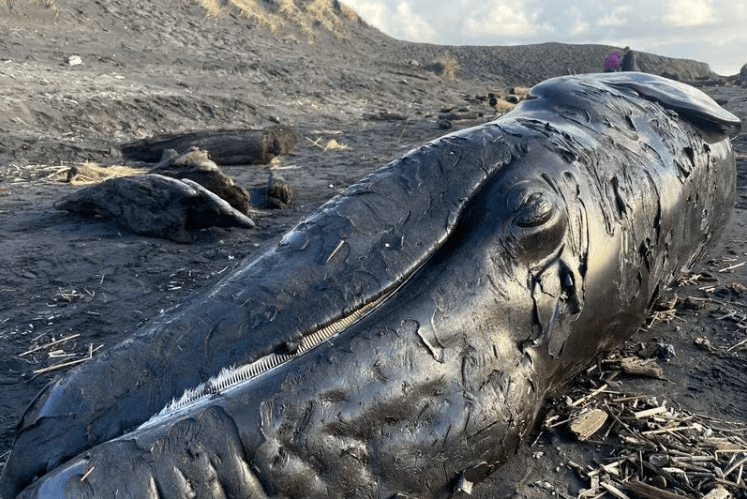Since 2019, nearly 700 dead gray whales have washed up on beaches in Canada, the United States, and Mexico. A new study suggested the die-off is a result of declining sea ice in the Arctic.
What's happening?
Gray whales have been experiencing a mass die-off over the past four years — 688, many of them malnourished, have washed up over the past five years. Scientists say that figure is likely only a fraction of the total number of dead whales, as the majority sink to the ocean floor.
"Humans .. I bet it's humans .." said one commenter on a Reddit post of the article, and they aren't entirely wrong.

A study published by researchers at Oregon State University says the die-off is likely fueled by declining sea ice in the Arctic. Algae growing on the underside of sea ice is eaten by benthic amphipods, which are a key part of gray whales' diet.
With global temperatures rising and Arctic sea ice melting, there is less algae for benthic amphipods to feed on. As benthic amphipods starve, there is less food available to gray whales.
Why is this die-off concerning?
Gray whales have experienced die-offs before. In 1999, federal agencies declared an "Unusual Mortality Event" among them. No cause was ever identified, and the population made a comeback.
This die-off has lasted twice as long and led to the deaths of twice as many whales as the 1999 die-off. Scientists estimate the gray whale population has declined to half its size in 2016, from 27,000 down to 14,500 gray whales.
Arctic sea ice is melting more rapidly than ever due to Earth's overheating. Scientists say the present die-off is showing signs of slowing, but if the ice continues to melt as quickly as it has been in recent years, one of the gray whales' primary food sources will continue to decline, putting whales at risk of starvation.
"[Gray whales are] resilient. They have the ability to adapt to changes in their environment and have been able to scrape by and recover, so I hope that they'll be able to do that moving forward as well," said Joshua Stewart, ecologist and assistant professor with Oregon State's Marine Mammal Institute and lead author of the study.
However, Stewart further said that regardless of this, the effects of rising global temperatures will not allow the Arctic to support as many gray whales as it has in the past, citing it as "tragic."
Not only are whales valuable for tourism and beneficial for coastal economies, but they can also help slow the rising temperatures threatening them. According to data from the International Monetary Fund, on average a whale can sequester 33 tons of carbon.
What's being done about the die-off?
Stewart told the Oregonian that, despite the continued melting of sea ice, there was some cause for optimism.
Stewart hopes further research will help scientists and conservationists better protect the gray whale population.
"We're hoping that by diving a little deeper into the causes we can maybe better predict what the future of the gray whale population will look like, and then take some lessons from that for other large whale species and populations that are maybe increasingly impacted by climate change," he told the Newsguard.
Join our free newsletter for easy tips to save more, waste less, and help yourself while helping the planet.
![“[Gray whales are] resilient ... so I hope that they’ll be able to do that moving forward as well."](https://www.thecooldown.com/wp-content/uploads/2023/12/TjggBpngyaEf.jpg?w=1920&h=800)








